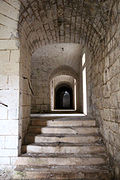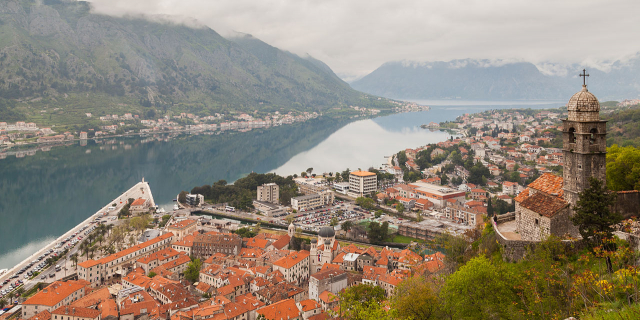Fort Gorazda (Montenegrin: Tvrđava Goražda/Тврђава Гораждa, German: Thurmfort Gorazda) is a fortification built by the Austro-Hungarian Empire near Kotor in Montenegro. The current fort was built between 1884–86 and replaced an earlier structure on the same site; its most notable feature is a 100-ton Gruson rotating turret on its roof, the last remaining example of its type. The fort was used by the Austrians in artillery duels against Montenegrin batteries stationed on Mount Lovćen during the First World War. The Montenegrins were unable to destroy it and were pushed out of range in 1916 by an Austrian offensive. The damage to the fort was repaired and its guns were removed to support the Austrian field army. It was used as a depot by the Yugoslav Army until as recently as the early 1990s. It was subsequently abandoned and can be visited by the public.
The fortress's predecessor was built prior to the 1869 uprising but was replaced with the current structure between 1884 and 1886. It was one of the first of the new fortresses around the Bay of Kotor to be constructed as part of the Austrians' late 19th century programme of improvements in the area. The two observation posts were installed in 1906–07. Although plans were mooted in 1910 to redevelop the fortress and install two new howitzer turrets and machine-gun and observation turrets, the outbreak of the First World War precluded this. During the war, it was garrisoned by 8 officers and 195 men and was armed with six 12 cm (4.7 in) minimum charter M80 mortars and two 10 cm (3.9 in) M4 casemate guns, plus three M4 machine guns, two M7 machine guns and 25 gun carriages.[1]
The fortress was heavily attacked by the Montenegrins from positions on Mount Lovćen, prompting the Austro-Hungarians to add the two concrete infantry positions on the roof in 1915 to guard against close-range attacks. Although it was bombarded with artillery weapons of up to 24 cm (9.4 in) calibre, they did little damage and in 1916 an Austrian offensive pushed Montenegrin forces out of artillery range. The fortress was repaired and stripped of its guns, which were used to support the Austrian field army. It was taken over by the Yugoslav Army following the war and continued to be used as an army depot until as recently as the early 1990s. It is now abandoned and is freely accessible by the public.[1] Its attractive situation has led to it being used on several occasions as a film location, most recently by the Italian production Il Cuore nel Pozzo in 2005. However, its accessibility and lack of protection by the state has meant that it has been extensively targeted by metal thieves, who have stolen many of the fort's interior fittings.[2]



































Add new comment